
Top 12 Tools for a CRM in Gmail That Work in 2025
Discover the 12 best tools to integrate a CRM in Gmail. Compare features, pricing, and use cases to find the perfect fit for your workflow in 2025.
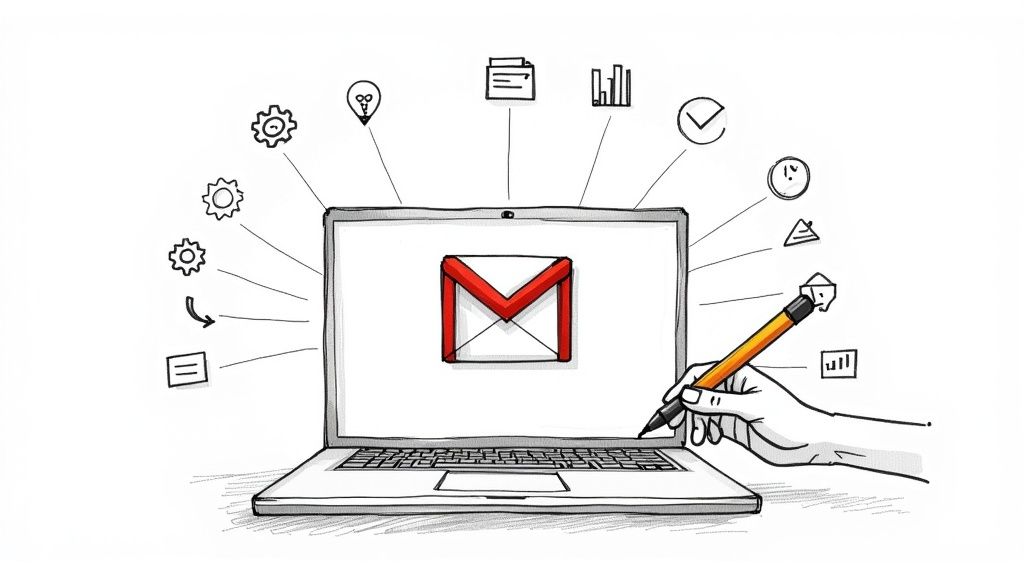
For sales teams and project managers, the email inbox is mission control. It's where conversations start, deals are negotiated, and relationships are built. However, manually tracking every lead, follow-up, and client detail across countless email threads is inefficient and prone to error. This disconnect between communication and data management is a major productivity drain, causing valuable opportunities to fall through the cracks. The solution isn't another separate platform; it's integrating your customer relationship management directly where the work happens.
This guide is your definitive resource for transforming your inbox into a powerful, centralized hub. We will explore the best tools that provide a full-featured CRM in Gmail, eliminating the need to constantly switch between your email and a separate CRM system. We'll dive deep into top contenders like Tooling Studio's Sales CRM, Streak, and HubSpot, providing a detailed analysis of their core functionalities, specific use cases, and practical integration steps.
Each entry includes screenshots and direct links, giving you a clear view of the user experience. You will learn how to manage sales pipelines, track customer interactions, and automate tasks without ever leaving your Google Workspace environment. This list is designed to help you quickly identify the right platform to streamline your workflow, close more deals, and maintain a complete, organized view of every customer relationship.
1. Sales CRM
Tooling Studio's Sales CRM stands out as a powerful and elegantly simple solution for teams deeply embedded in the Google Workspace ecosystem. It fundamentally rethinks the concept of a CRM by building directly upon your existing Google Contacts, transforming them into a dynamic sales management system without requiring you to learn a new, complex platform. This approach makes it an exceptional choice for anyone looking for a CRM in Gmail that feels native, not bolted on.
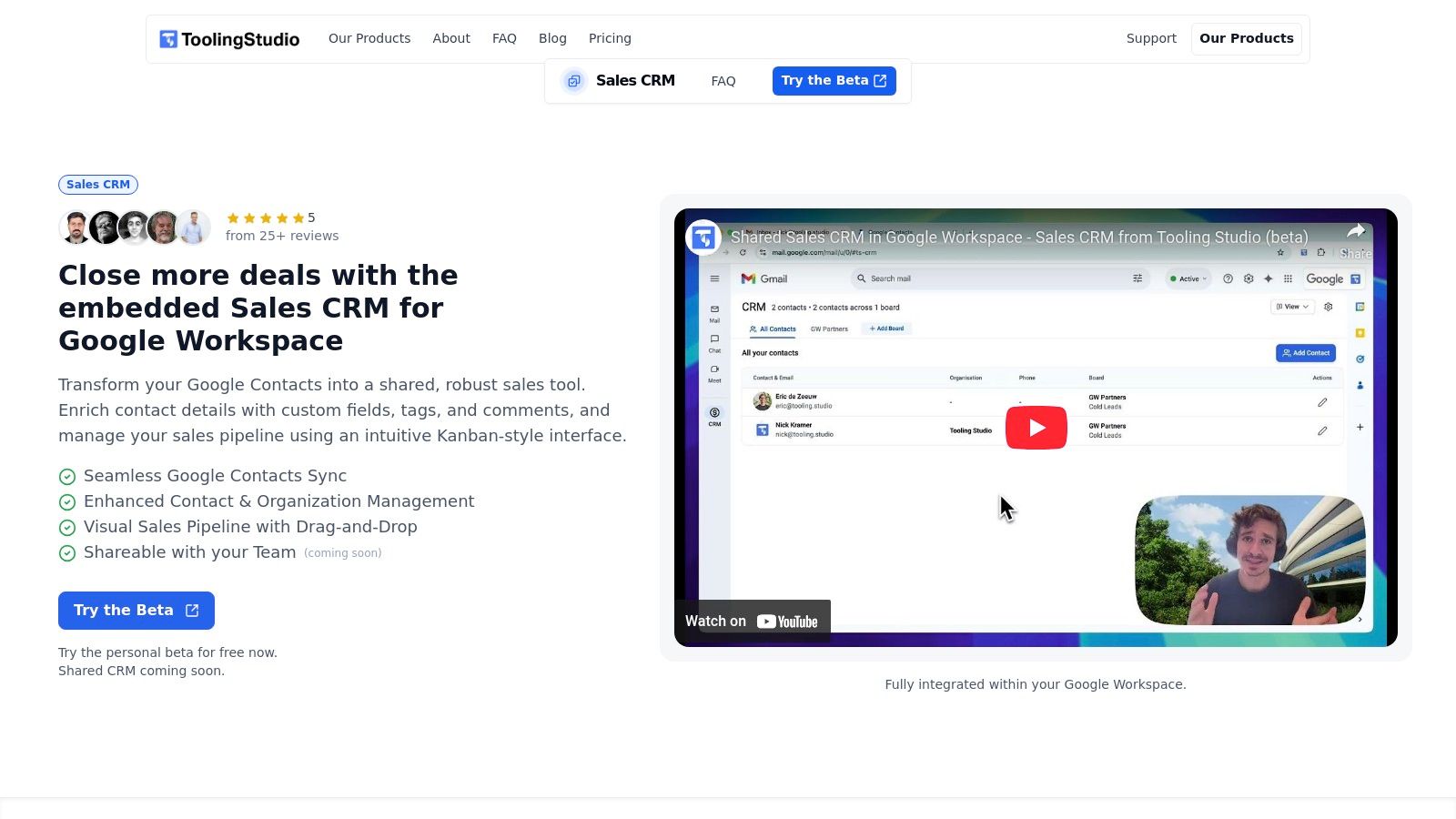
The platform’s strength lies in its seamless integration. By leveraging Google Contacts as its foundation, it eliminates data silos and duplicate entry, ensuring your single source of truth for customer information remains within Google. Its lightweight Chrome extension design means performance is fast and responsive, avoiding the bloat often associated with more cumbersome CRM systems.
Standout Features and Use Cases
This CRM excels with its visual sales pipeline, a Kanban-style board that provides an at-a-glance overview of every deal's status. Sales teams can drag and drop contacts between stages, update deal values, and track progress directly within their familiar Google environment. This intuitive interface is ideal for collaborative selling, allowing team members to share context and manage handoffs without ever leaving their inbox.
For a deeper dive into its capabilities, explore the benefits of Gmail CRM integration. The customizable contact management system also allows you to tailor data fields to your specific sales process, ensuring the information you track is always relevant.
Key Advantage: By operating directly on Google Contacts, this tool minimizes workflow disruption and learning curves, making adoption nearly effortless for teams already using Google Workspace.
Practical Considerations
- Pros: Native integration with Google Workspace, an intuitive visual sales pipeline, strong collaborative features, customizable contact management, and a fast, lightweight extension.
- Cons: As a beta product, some advanced features may still be in development. Its core focus on Google Workspace makes it unsuitable for teams using other email or productivity suites.
Access: The Sales CRM is available as a Chrome extension. As it's currently in beta, users can join the waitlist to gain early access, providing an opportunity to influence its development with direct feedback.
2. Streak CRM
Streak positions itself as the original CRM in Gmail, transforming your inbox into a flexible, all-in-one workspace. Its core strength lies in its deep, native integration, allowing users to manage entire business workflows-from sales and hiring to project management-without ever leaving their email interface. This approach is particularly effective for small teams and solopreneurs who prioritize simplicity and want to avoid the learning curve of a separate, complex CRM platform.

The platform uses customizable "pipelines" that appear alongside your emails, letting you visually track the progress of contacts, deals, or candidates through different stages. This makes it an incredibly intuitive system for anyone familiar with a spreadsheet-like interface.
Key Features & User Experience
- Customizable Pipelines: Adapt pipelines for any process, such as sales, support tickets, or bug tracking, directly within Gmail.
- Email Power Tools: Includes email tracking, mail merge for personalized bulk sends, and snippets for frequently used text.
- Seamless Integration: Everything is managed inside Gmail, which means no tab-switching and a unified workflow.
Practical Tip: Use Streak’s "Magic Columns" feature to automatically enrich your pipeline data. It can pull information like the date a contact was added, the number of emails exchanged, or the last interaction time, providing valuable insights with zero manual entry.
Streak offers a generous free plan for individual use, with paid plans starting at $49 per user/month, which unlock unlimited pipelines and advanced features. While the free version is robust, users with large datasets may notice a performance lag. For those evaluating their options, Tooling Studio offers a comprehensive comparison of Gmail-integrated CRMs to help you decide.
Website: https://www.streak.com/
3. HubSpot CRM
HubSpot offers a powerful and comprehensive CRM in Gmail, positioning itself as a central hub for marketing, sales, and service activities. Unlike solutions built exclusively inside the inbox, HubSpot provides a full-featured external CRM platform that syncs seamlessly with Gmail. This makes it ideal for growing businesses that need robust reporting, automation, and contact management capabilities without sacrificing the convenience of working from their email.

The Gmail extension brings essential CRM tools directly into your inbox, allowing you to log emails, manage contacts, and access templates on the fly. This hybrid approach gives users the best of both worlds: in-context email tools and a scalable backend platform for deeper analysis and team collaboration.
Key Features & User Experience
- Email Tracking & Logging: Get real-time notifications when emails are opened and automatically log correspondence to a contact’s timeline.
- Meeting Scheduler: Share a link that lets prospects book meetings directly on your calendar, eliminating back-and-forth emails.
- Contact Management: View a contact's entire interaction history, associated deals, and tasks in a convenient sidebar next to your emails.
Practical Tip: Use HubSpot’s "Sequences" feature to automate a series of personalized follow-up emails. This ensures no lead falls through the cracks and saves you significant time on manual outreach, all managed from your Gmail interface.
HubSpot’s core CRM is famously free and includes a generous set of tools. Paid "Hubs" (starting at $45/month) unlock advanced automation and reporting. While incredibly powerful, the sheer breadth of features can present a steeper learning curve than simpler tools. For a deeper dive, explore this guide on the best CRMs for Google Workspace to see how it compares.
Website: https://www.hubspot.com/
4. Copper CRM
Copper markets itself as the CRM for Google Workspace, providing a truly native experience that feels like a natural extension of Gmail and other Google apps. It's designed for small to medium-sized businesses that are heavily invested in the Google ecosystem and want a CRM that eliminates tedious data entry. Copper’s standout feature is its ability to automatically capture and sync all your interactions-emails, meetings, and files-directly from Gmail.

This deep integration allows teams to manage their entire sales pipeline and customer relationships without ever leaving their inbox. The user-friendly interface appears as a sidebar in Gmail, providing instant context on every contact and deal, which greatly accelerates user adoption.
Key Features & User Experience
- Automatic Data Entry: Scrapes Gmail for contact details, email threads, and meeting schedules to build contact profiles automatically.
- Google Workspace Integration: Works seamlessly with Google Calendar, Drive, and Sheets, linking all relevant documents and events to contacts.
- Visual Sales Pipelines: Offers a clear, drag-and-drop interface to track leads and deals through customizable stages.
Practical Tip: Connect Copper with Google Sheets to create powerful, live dashboards. You can export pipeline data directly to a sheet and use it to build custom reports and forecasts that update automatically, giving leadership a real-time view of sales performance.
Copper’s pricing starts with its Basic plan at $23 per user/month, with more advanced features available in higher-tiered plans. While it is a premium crm in gmail solution, its automation capabilities justify the cost for teams looking to maximize efficiency and minimize manual tasks.
Website: https://www.copper.com/
5. Zoho CRM
Zoho CRM is a powerhouse in the customer relationship management space, and its integration with Gmail makes it a formidable option for growing businesses. It bridges the gap between a standalone, feature-rich CRM and the convenience of an inbox tool. This approach is ideal for sales teams that need robust automation and detailed analytics but want to manage email-based interactions without constant app switching, making it an excellent CRM in Gmail solution for scaling operations.
The platform excels at turning your inbox into a lead-generation machine. Incoming emails from new contacts can be automatically converted into leads or contacts within Zoho CRM, ensuring no opportunity falls through the cracks. This deep integration is perfect for teams that manage a high volume of inbound inquiries and need to maintain a structured, organized follow-up process.
Key Features & User Experience
- Advanced Automation: Create complex workflows that trigger actions based on email activity, saving significant time on manual data entry.
- AI-Powered Assistant: Zoho’s AI, Zia, provides smart suggestions, predicts deal outcomes, and helps identify the best time to contact a lead.
- Comprehensive Analytics: Generate detailed reports on sales performance, email engagement, and team productivity directly from CRM data.
Practical Tip: Use the "GameScope" feature to create sales contests and goals based on CRM activities logged through the Gmail integration. This gamification can motivate your team to keep contact records updated and drive engagement.
Zoho offers a free-forever plan for up to three users. Paid plans start at a competitive $14 per user/month, making its advanced functionality accessible. While the interface can feel complex for new users, its extensive customization options are a major advantage for businesses with specific process requirements.
Website: https://www.zoho.com/crm/
6. NetHunt CRM
NetHunt CRM is a powerful sales automation tool designed to bring the full functionality of a CRM in Gmail. It excels at turning your inbox into a centralized command center for sales activities, making it a strong contender for sales teams that live and breathe within the Google Workspace ecosystem. Its main differentiator is the depth of its features, which rival those of standalone CRMs while remaining accessible directly beside your emails.
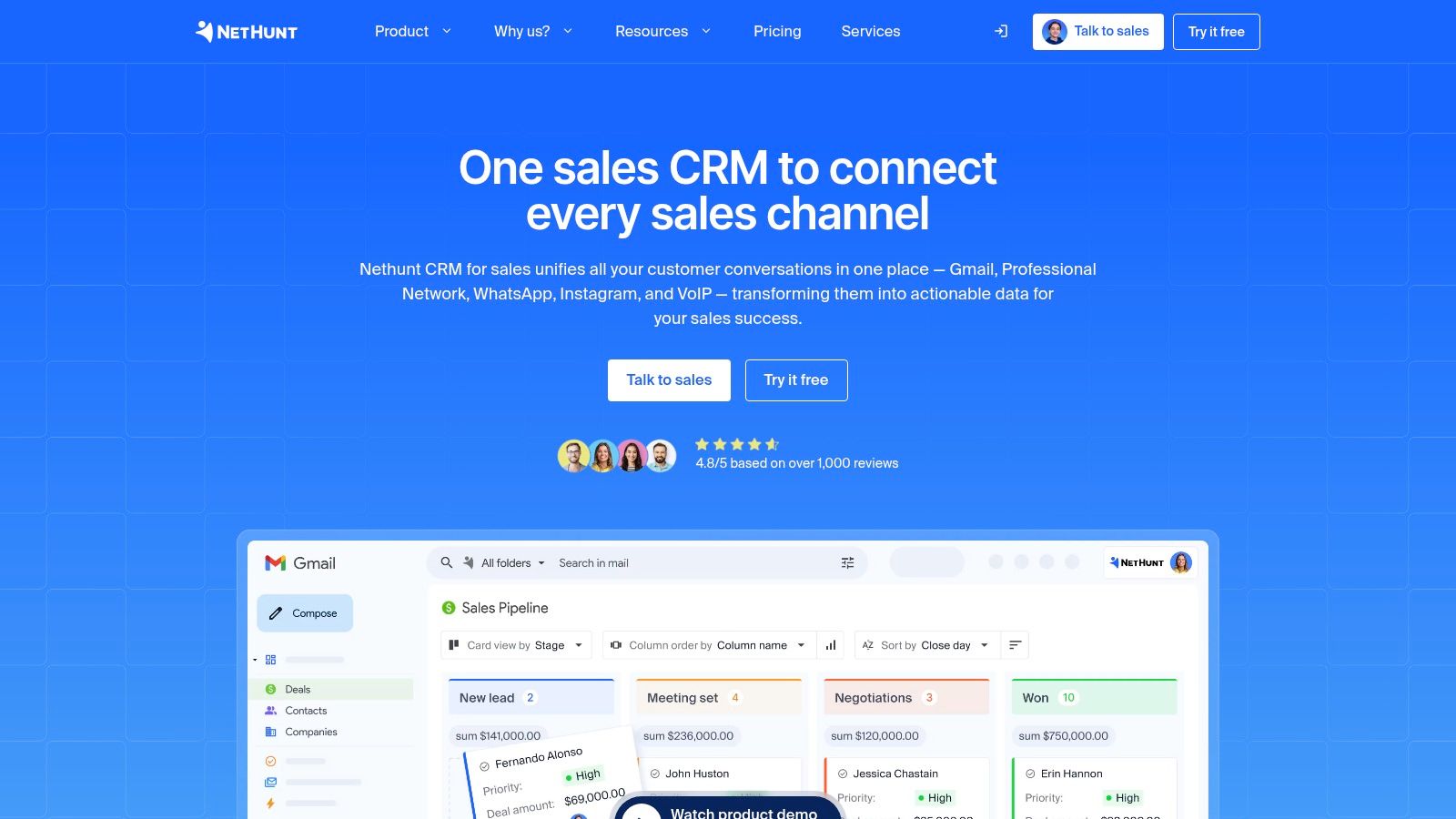
The platform organizes everything from contacts and deals to support tickets into clear, manageable records that are automatically linked to your email conversations. This ensures context is never lost and follow-ups are always timely, streamlining the entire sales cycle.
Key Features & User Experience
- Automated Email Campaigns: Build and schedule personalized email sequences and follow-ups that trigger based on user actions.
- Pipeline Visualization: Manage deals with a drag-and-drop Kanban-style board inside Gmail, offering a clear view of your sales funnel.
- Detailed Analytics: Access comprehensive reports on team performance, pipeline health, and campaign effectiveness without leaving your inbox.
Practical Tip: Use NetHunt's "Email Drips" feature to automate your outreach. You can create multi-stage campaigns that send follow-up emails automatically if a recipient doesn't reply, saving you hours of manual work and ensuring no lead falls through the cracks.
NetHunt offers a 14-day free trial, with paid plans starting at $24 per user/month. While its Google integration is best-in-class, its connections with non-Google services are more limited. This makes it ideal for teams fully committed to Google Workspace.
Website: https://nethunt.com/
7. Pipedrive
Pipedrive is a sales-first CRM renowned for its clean, visual approach to pipeline management. While not a native Gmail application, its robust integration brings powerful sales tracking capabilities directly into your inbox. The platform is designed for sales teams who need a clear, activity-based method to move deals forward, making it a strong contender for those who find traditional CRMs overly complex or cluttered. Its core philosophy is to simplify the sales process, ensuring users focus on actions that close deals.
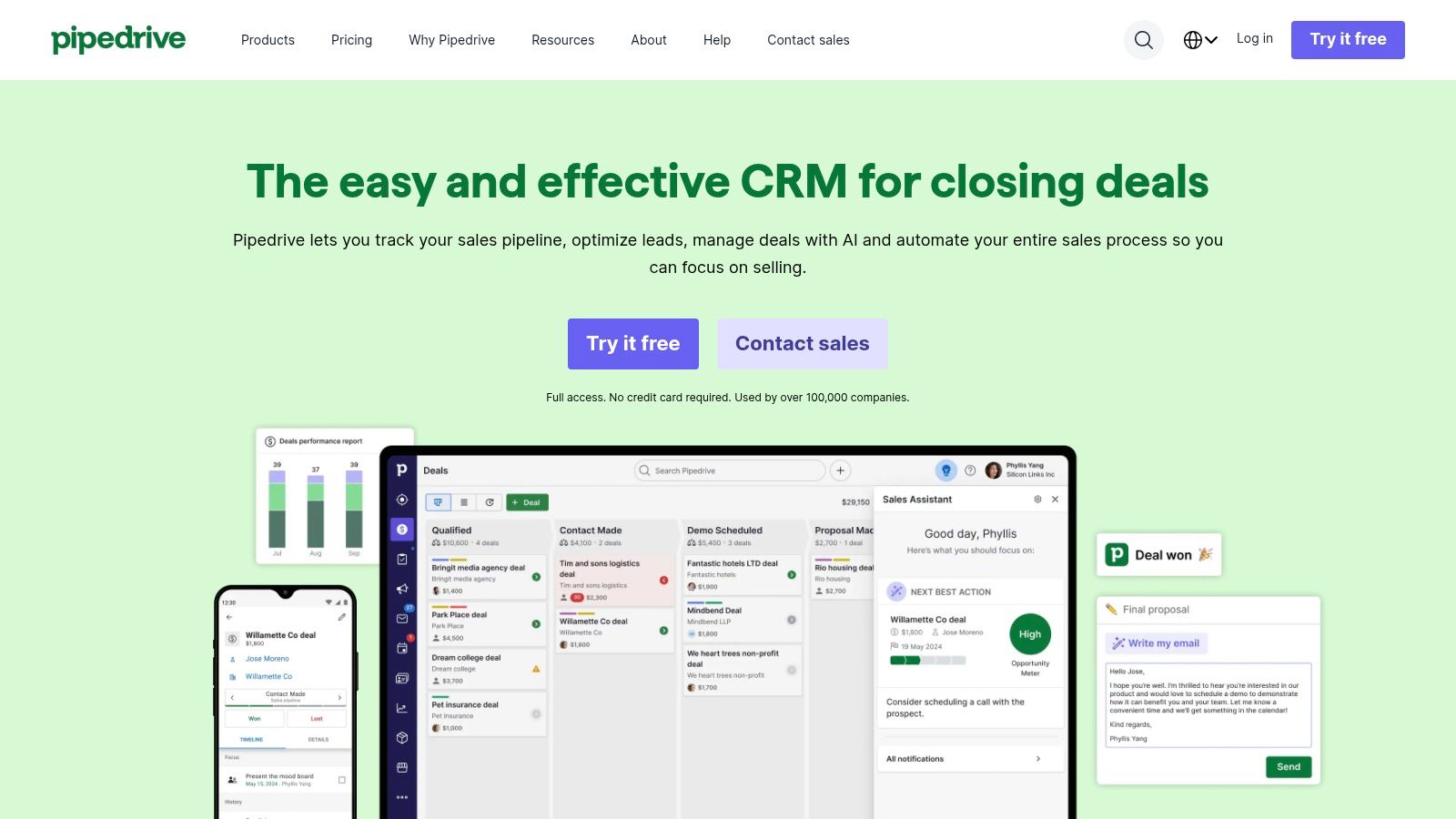
The Gmail add-on allows you to see the context of any contact’s deal history right next to your emails. You can add new contacts, create deals, and schedule activities without switching tabs, which is a significant time-saver for busy sales reps. This makes it an excellent CRM in Gmail for teams that live in their inbox but require a structured sales backend.
Key Features & User Experience
- Visual Sales Pipeline: A clear, drag-and-drop interface to track deal progress through custom stages.
- Activity-Based Selling: Prompts users to schedule their next action (call, email, meeting) for every deal.
- Gmail Integration: Adds a sidebar to your inbox to manage contacts, deals, and activities directly from your email threads.
Practical Tip: Use Pipedrive’s workflow automation to trigger actions based on deal movement. For example, automatically create a follow-up task for your team leader when a deal moves into the "Negotiation" stage, ensuring key opportunities get extra attention.
Pipedrive's plans start at $14 per user/month (billed annually), with more advanced features available in higher tiers. While its sales focus is a major strength, businesses looking for deep marketing automation may find it limited. The user-friendly interface, however, makes it incredibly easy to onboard new team members quickly.
Website: https://www.pipedrive.com/
8. Insightly
Insightly offers a unique blend of CRM and project management, positioning itself as a unified platform for customer-facing and internal workflows. Its CRM in Gmail integration allows teams to save emails, track communications, and link important messages directly to contacts, organizations, or active projects. This dual functionality is ideal for businesses that manage long-term client relationships which often involve detailed, multi-stage projects after the initial sale is complete.
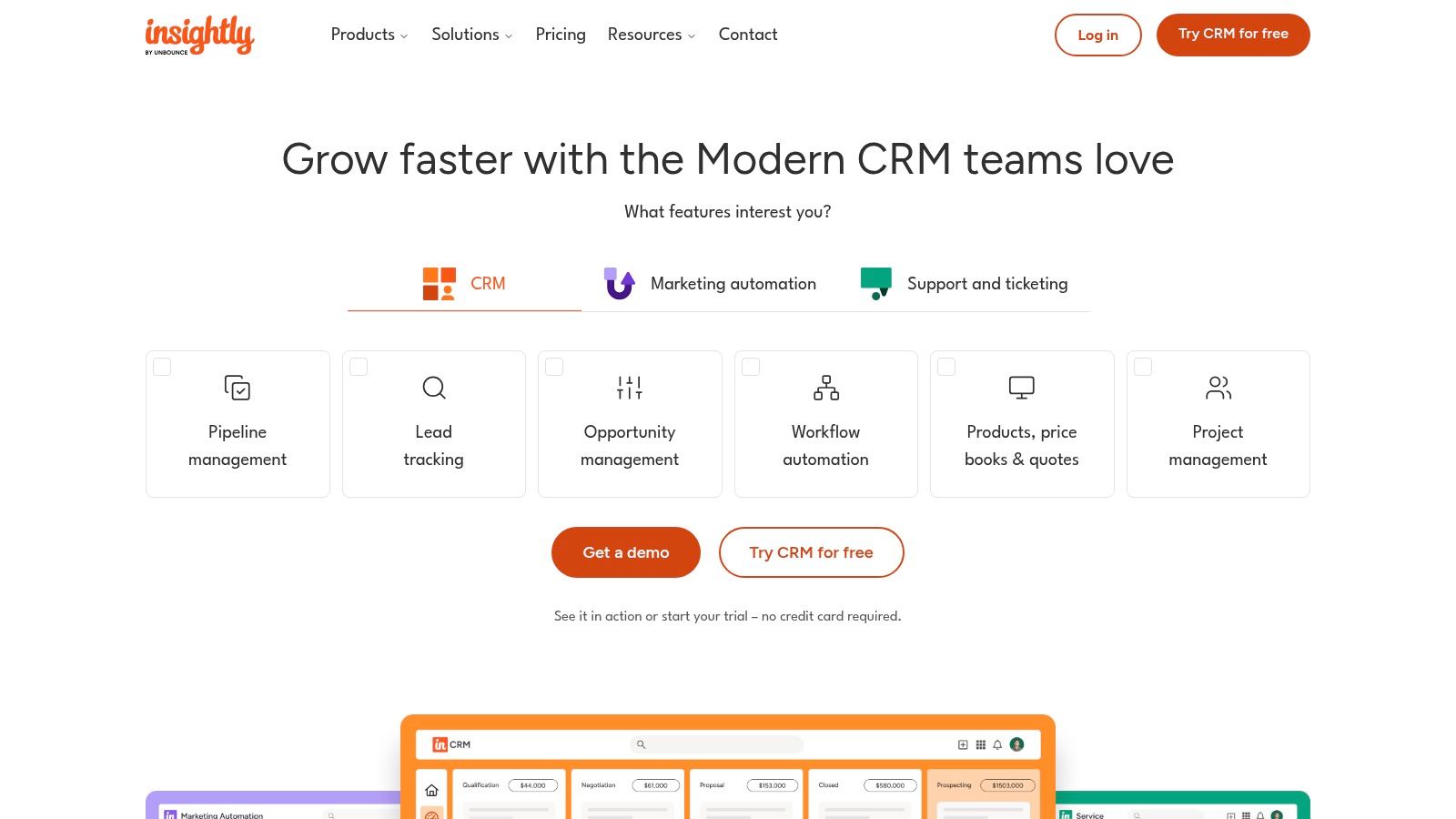
The platform stands out by connecting the sales pipeline directly to project delivery. Once a deal is won, it can be converted into a project with all associated contacts and email history intact, ensuring a smooth handoff from sales to operations without losing critical context.
Key Features & User Experience
- Gmail Integration: Save emails and their attachments to Insightly records directly from your inbox.
- Project Management: Create projects with milestones, task lists, and deadlines linked to your CRM data.
- Workflow Automation: Automate common tasks like lead assignment, email alerts, and record updates.
- Customizable Dashboards: Build reports and dashboards to visualize sales performance and project progress side-by-side.
Practical Tip: Use the Insightly Gmail add-on to not only save emails but also create new tasks or events directly from an email. This is perfect for when a client email contains an actionable request that needs to be tracked within a project.
Insightly provides a free plan for up to two users, with paid plans starting at $29 per user/month. While it offers a powerful combination of features, users have noted that customer support response times can sometimes vary.
Website: https://www.insightly.com/
9. Salesmate
Salesmate is a robust CRM in Gmail designed specifically for sales teams operating within the Google Workspace ecosystem. It excels by providing deep, two-way synchronization with Gmail, ensuring that all communications, calendar events, and contacts are automatically logged and updated. This eliminates tedious manual data entry and provides a single source of truth for all sales activities, making it ideal for teams that need to move fast and stay aligned without leaving their inbox.
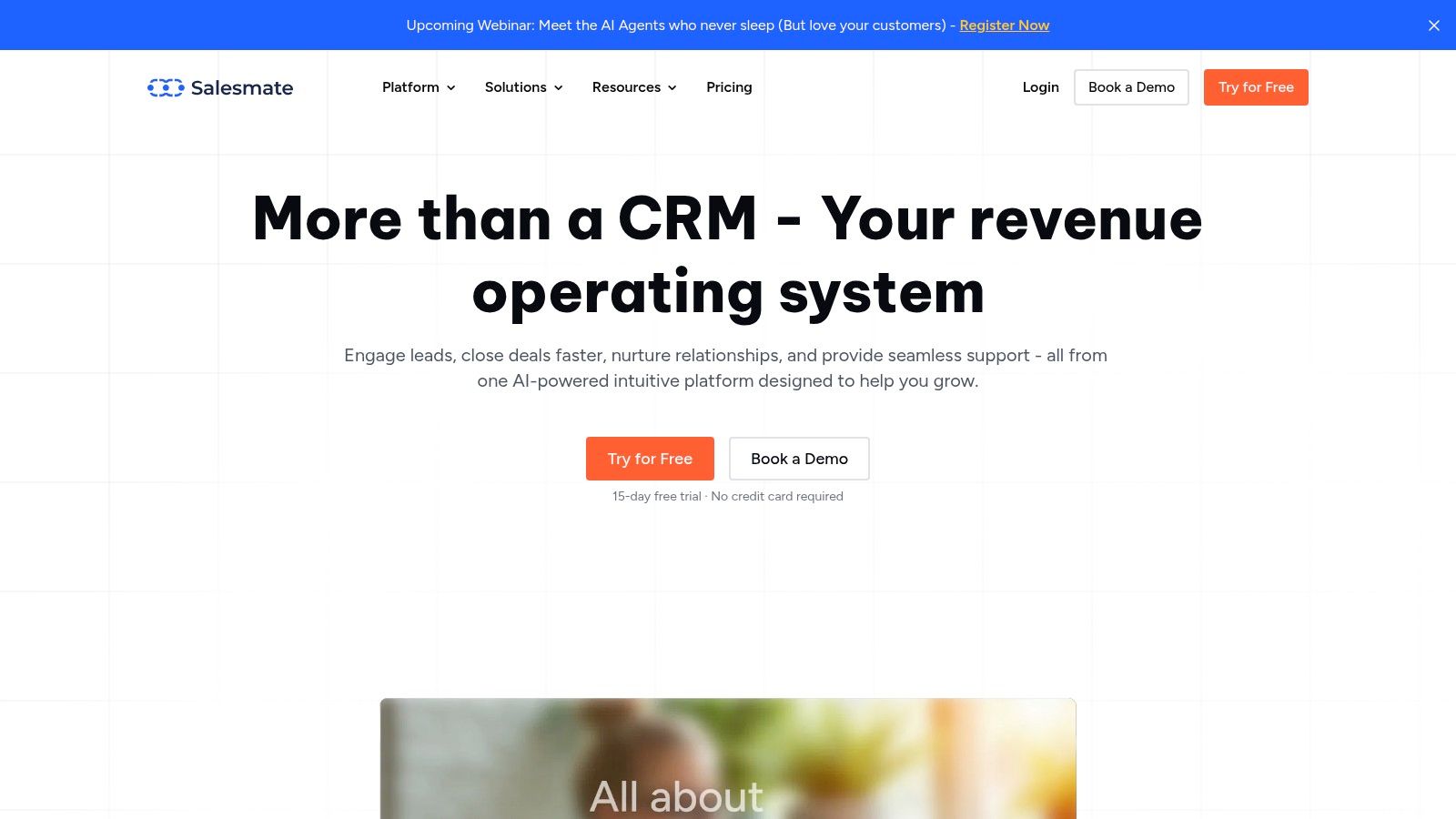
The platform is recognized for its quick setup and intuitive interface, which simplifies the onboarding process for new teams. Its powerful automation features and visual sales pipelines help representatives track deals and prioritize tasks effectively directly from their email client.
Key Features & User Experience
- Two-Way Gmail Sync: All emails sent or received are automatically logged to the relevant contact, deal, or company record in Salesmate.
- Visual Sales Pipelines: Easily track deals through various stages with a clear, drag-and-drop interface inside Gmail.
- Built-in Calling & SMS: Engage with prospects through multiple channels without needing to switch between different applications.
- Extensive Integrations: Connects with over 700 business apps, allowing for a highly customized and powerful tech stack.
Practical Tip: Leverage Salesmate's Sequences feature to automate your email follow-ups. You can create multi-stage, personalized email campaigns that stop automatically once a contact replies, saving significant time and ensuring no lead falls through the cracks.
Salesmate offers a 15-day free trial, with paid plans starting at a competitive price point. While the platform is powerful, be mindful of the daily email sending limits on lower-tier plans.
Website: https://www.salesmate.io/
10. Keap CRM
Keap positions itself as a robust all-in-one CRM in Gmail and marketing automation platform, specifically designed for established small businesses ready to scale. While many tools focus solely on inbox management, Keap provides a comprehensive suite that combines sales, marketing, and client management. Its Gmail integration brings core CRM functionalities directly to your inbox, allowing you to log emails, trigger automated follow-ups, and manage contacts without leaving your email workflow.
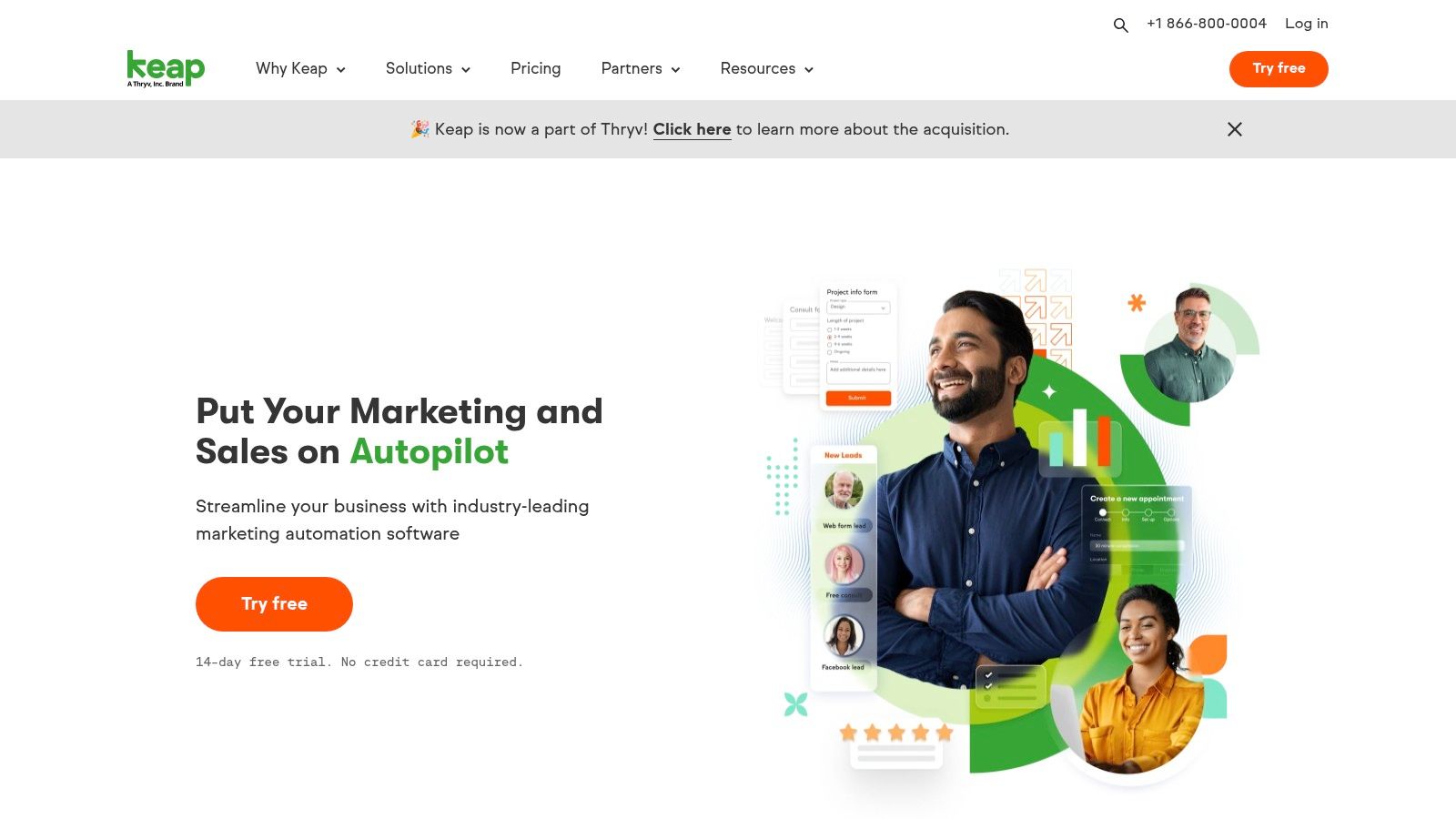
This platform stands out by bundling powerful automation with its CRM features. It’s ideal for service-based businesses that need to manage leads, send proposals, and process payments all from one place. The integration ensures that crucial email conversations are automatically captured in the contact’s record, providing a complete history for your team.
Key Features & User Experience
- Advanced Automation: Create sophisticated "if-then" automation sequences for follow-ups, lead nurturing, and client onboarding.
- Gmail Sidebar: Access contact details, add notes, and trigger automations from a convenient sidebar within your Gmail interface.
- Integrated Invoicing: Send invoices and process payments directly through Keap, connecting your sales process to your revenue.
- Email Marketing: Utilize a library of customizable templates and A/B testing for effective email campaigns.
Practical Tip: Leverage Keap's appointment booking feature and integrate it with your email signature. When a lead schedules a meeting, Keap can automatically create a contact record and trigger a pre-call nurture sequence, saving you significant administrative time.
Keap's pricing starts at a higher point, around $159/month for two users, reflecting its extensive feature set. While it may be overly complex for solopreneurs or very small teams, it offers immense value for businesses needing a unified system for sales and marketing automation.
Website: https://www.keap.com/
11. ActiveCampaign
ActiveCampaign is a powerhouse of marketing automation and sales CRM that extends its functionality into your inbox. While not a native CRM in Gmail in the same vein as Streak, its Gmail integration connects its powerful automation engine directly to your email communications. This setup is ideal for businesses that need sophisticated marketing workflows, lead scoring, and sales automation but want to manage key contact interactions without leaving Gmail.

The integration, often via a Chrome extension, provides a side panel in Gmail where you can see a contact’s deal status, recent activities, and associated automation. This allows you to add new contacts to your CRM, assign tasks, and trigger complex marketing sequences directly from an email, blending high-level automation with personal communication.
Key Features & User Experience
- Advanced Automation: Build intricate workflows for email marketing, lead nurturing, and customer onboarding that react to user behavior.
- Integrated Sales CRM: Manage deals, pipelines, and tasks with automations that can move leads through your sales process automatically.
- Lead Scoring: Automatically score contacts based on their engagement, helping your sales team prioritize the most promising leads.
Practical Tip: Use the Gmail integration to quickly add a hot lead from an email exchange into a specific "Welcome" or "Nurture" automation in ActiveCampaign. This instantly enrolls them in a targeted communication sequence without any manual data entry in the main platform.
Pricing starts at $29/month for the Marketing Lite plan, with CRM features included in higher-tier plans. The platform's depth can present a learning curve for those new to automation, but its extensive capabilities make it a strong contender for scaling businesses.
Website: https://www.activecampaign.com/
12. Hiver
Hiver transforms your Gmail into a powerful, multi-channel help desk, making it a unique player in the CRM in Gmail space. Rather than focusing on sales pipelines, Hiver is designed for customer service and support teams who live inside Google Workspace. It allows teams to manage shared inboxes like support@ or info@ directly from their personal Gmail accounts, ensuring no customer query gets lost.
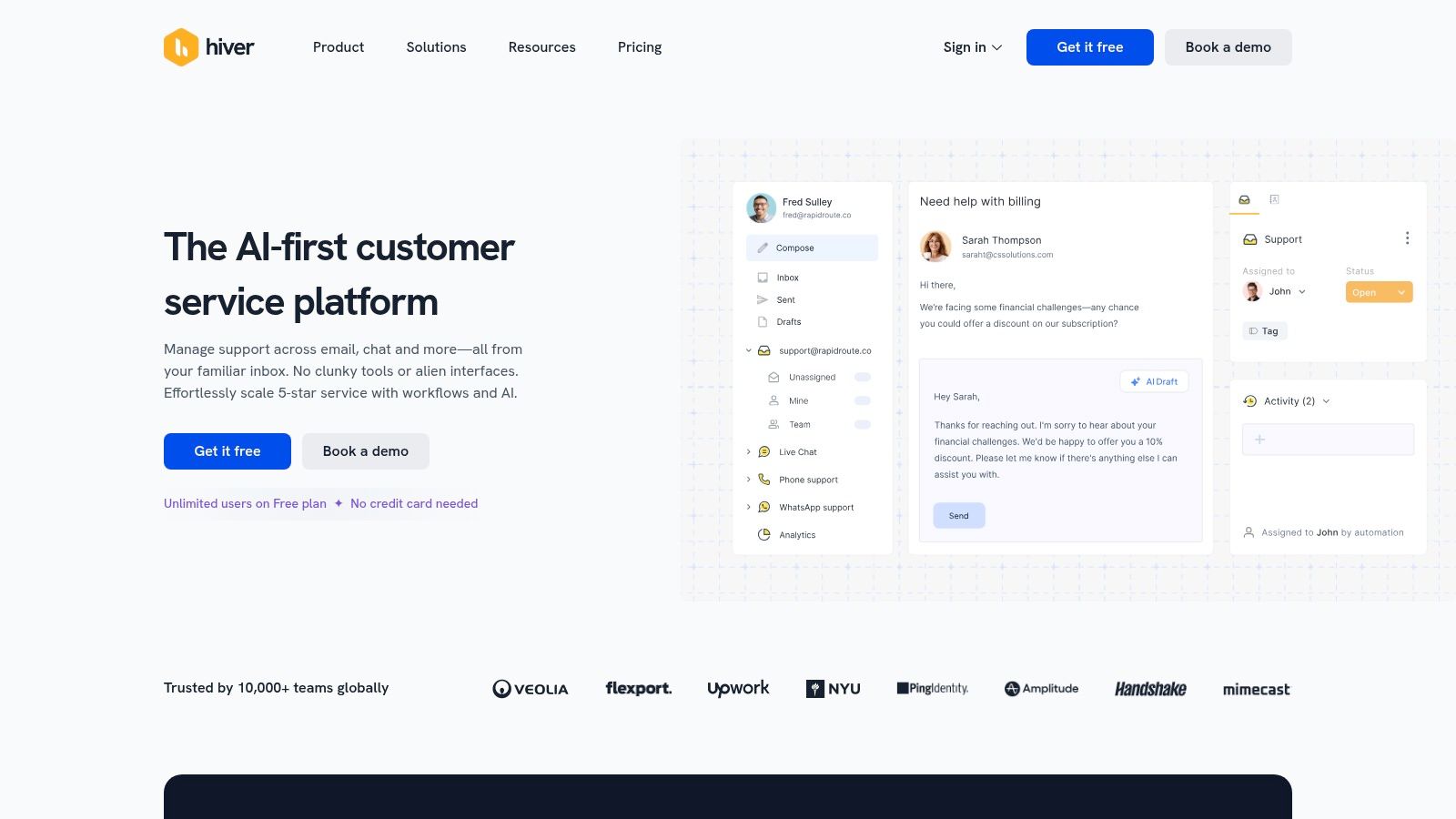
This approach eliminates the need for external help desk software, centralizing communication and improving team collaboration on support tickets. By assigning emails, tracking resolution times, and adding internal notes, Hiver makes customer support a transparent and efficient process within a familiar interface.
Key Features & User Experience
- Shared Inbox Management: Manage group emails like
support@orsales@without leaving your personal Gmail. - Workflow Automation: Set up rules to automatically assign emails, add tags, and prioritize tasks based on keywords or sender.
- SLA Management & Analytics: Track key support metrics like response time and resolution time to ensure you meet customer expectations.
- Multi-channel Support: Consolidate communications from email, live chat, and voice channels directly within Gmail.
Practical Tip: Use Hiver's "Collision Alerts" to avoid duplicate replies. If a team member is already viewing or responding to an email in a shared inbox, Hiver notifies others in real-time, preventing confusion and ensuring a unified customer experience.
Hiver's pricing starts at $15 per user/month. While its integration is seamless and the interface is user-friendly, the platform's customization options can be limited compared to dedicated, standalone help desk solutions.
Website: https://hiverhq.com/
CRM Features and Integration Comparison
| Product | Core Features/Integration ✨ | User Experience ★★★★☆ | Value Proposition 💰 | Target Audience 👥 | Unique Selling Points 🏆 | Price Points 💰 |
|---|---|---|---|---|---|---|
| Sales CRM | Native Google Contacts & Workspace integration, customizable pipeline | Lightweight, responsive, beta-stage | Centralized sales in Gmail | Sales pros, teams in Google Workspace | Visual sales pipeline, collaborative UX | Beta/free (pricing TBD) |
| Streak CRM | Customizable pipelines, email tracking, mail merge | User-friendly, seamless Gmail integration | Free plan, intuitive for SMBs | Small biz, solopreneurs, consultants | In-inbox CRM, easy setup | Free plan + paid tiers |
| HubSpot CRM | Email tracking, templates, scheduling, deal pipelines | Intuitive, easy setup | Comprehensive free tier | All business sizes | Extensive integrations, strong free plan | Free + paid plans |
| Copper CRM | Auto email logging, Google Calendar/Drive integration | User-friendly, native Google Workspace | Deep Gmail integration | SMBs using Google Workspace | Minimal manual entry, native sync | Higher price tier |
| Zoho CRM | Email lead capture, AI assistant (Zia), analytics | Feature-rich, potentially complex UI | Competitive pricing, highly customizable | Growing SMBs | AI-powered sales assistant | Affordable pay plans |
| NetHunt CRM | CRM dashboard in Gmail, automation, pipeline mgmt | Intuitive, Gmail-native | Strong automation capabilities | Sales teams using Gmail | Gmail inbox as CRM | Tiered plans |
| Pipedrive | Visual sales pipeline with drag-drop, automation | Easy setup, user-friendly | Sales-focused, broad integrations | Sales teams | Visual sales pipeline focus | Paid plans |
| Insightly | CRM + project mgmt, workflow automation | User-friendly, combines CRM & projects | Affordable, multipurpose | SMBs needing CRM + project tools | CRM + project management combo | Affordable pricing |
| Salesmate | Two-way Gmail sync, sales pipeline, 700+ integrations | Quick, intuitive setup | Good value, trial available | Google Workspace sales teams | Extensive app integration | Affordable, trial offered |
| Keap CRM | Gmail logging, marketing automation, invoicing | Robust feature set, may be complex | All-in-one for SMBs | Small biz, solopreneurs | Integrated marketing & invoicing | Higher starting price |
| ActiveCampaign | Email marketing & CRM automation, lead scoring | User-friendly, robust features | Extensive marketing automation | SMBs needing marketing + CRM | Marketing & CRM combo with wide integrations | Paid plans, higher cost |
| Hiver | Shared inbox, AI assistance, SLA mgmt, multichannel support | Simple interface, enhances support teams | Collaboration focus | Customer support teams | Gmail-native helpdesk | Paid plans, tiered |
Moving Beyond the Inbox: Your Next Steps to a Streamlined Workflow
Navigating the landscape of Gmail-integrated CRMs can feel overwhelming, but the potential payoff is a streamlined, powerful, and unified workflow. We have journeyed through a dozen of the top contenders, from robust enterprise-level platforms like HubSpot and Zoho to nimble, inbox-native solutions like Streak and Sales CRM. The core takeaway is clear: the most effective CRM in Gmail is not a one-size-fits-all solution but the one that aligns perfectly with your team’s unique processes, size, and growth trajectory.
Your inbox is no longer just a communication hub; it's the central nervous system of your business operations. By embedding a CRM directly within it, you eliminate the friction of context-switching, reduce manual data entry, and empower your team with the information they need, precisely when they need it. The right tool transforms reactive email management into a proactive strategy for nurturing leads, managing projects, and closing deals.
How to Choose Your Ideal Gmail CRM
Making the final decision requires a thoughtful evaluation of your specific needs. To guide your choice, consider these critical factors:
- Primary Use Case: Are you a sales-focused team needing intricate pipeline management (like Pipedrive or Salesmate), or do you require a more flexible system for various business processes like hiring or support (like Streak or NetHunt)? Defining your primary goal is the most crucial first step.
- Team Size and Scalability: A freelancer or a small team might find the simplicity and direct integration of Sales CRM or Hiver perfectly sufficient. Conversely, a growing SME should consider the scalability and broader feature sets of platforms like Copper or HubSpot, which can evolve with your business.
- Implementation and Adoption: How much time and technical expertise can you invest? Tools like Streak boast a near-instant setup, living entirely inside Gmail. Others, like Zoho or Insightly, may require more dedicated configuration to leverage their full potential, involving integration with other parts of their ecosystem.
- Budget and True Cost: Look beyond the initial subscription price. Factor in the cost per user, potential add-ons for advanced features, and any implementation support you might need. Many tools offer generous free tiers, providing an excellent, risk-free way to test their CRM in Gmail capabilities.
Your Action Plan for Implementation
Once you have a shortlist, your path forward should be methodical. First, leverage free trials or demos for your top two or three choices. Create a small pilot group within your team to test the tools in real-world scenarios for a week. Gather feedback on usability, key features, and how well the tool integrates into their daily routine. This hands-on approach provides invaluable insights that no feature list can replicate. Remember, the best tool is the one your team will actually use consistently.
The journey to finding and implementing the perfect CRM in Gmail is an investment in your team's productivity and your company's growth. By moving your customer relationship management out of disparate spreadsheets and into the heart of your daily communications, you are not just adopting new software; you are building a more connected, efficient, and intelligent way to work.
Ready to transform your Gmail into an organized, powerful command center? Explore how Tooling Studio's suite of extensions, including our lightweight Sales CRM, can help you manage pipelines, track contacts, and streamline your workflow without ever leaving your inbox. Visit Tooling Studio to start optimizing your process today.